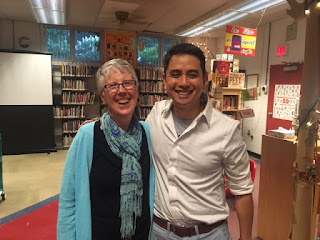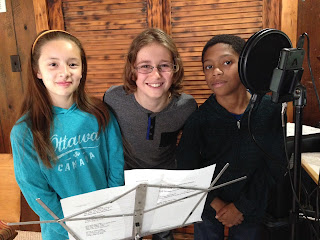Over the past few years, I've gotten to known Minh, Aimee, Jacob (now a rising first grader) and their newest family member, preschooler Ezra, as both library patrons and friends. And it's been fun having a front row seat as Minh's reputation, both as a reviewer and a picture book author, has grown nationally. When Minh published his first picture book, Let Me Finish! in 2016, he came to my library to read and talk about the book, along with the book's illustrator, Isabel Roxas. Also on hand was the book's editor, Rotem Moscovich, who made the trip down from NYC, bringing a specially decorated cake for the program. Let Me Finish! won praise from critics and marked Minh as a picture book creator to watch.
Fast forward to this year, when Minh published his second picture book, Drawn Together, which details how art allows a young boy who only speaks English to communicate with his Thai-speaking grandfather. It's not your normal second picture book, however. First of all, while it's a very personal book for Minh, it also has a universal message that seems to resonate with everyone who reads it. Second of all, the illustrator for the book is Caldecott Medalist Dan Santat, and when you've got a Caldecott Medalist illustrating your picture book, you know that it's going to be something special.
So it's really no surprise that Drawn Together has won raves from critics, including starred reviews from all of the major professional children's book review journals. The book also is an "Indie Choice" in the newsletter published by independent bookstores around country, and it was sporlighted early this month as an "editor's choice" by The New York Times, which called it "at once touching and thrilling." Personally, I believe it's got a great shot at winning the 2019 Caldecott Medal, or at least a Caldecott Honor (although, of course, the actual Caldecott Committee operates in secret, so we have no idea of what they are considering).
 |
| Photo by Maurice Belanger |
Interestingly, Minh wrote Drawn Together based on his experience as a Vietnamese-American, while Dan Santat's illustrations portray a Thai grandfather and his Thai-American grandson. In a recent interview with me, Minh noted that he's thrilled with Dan's portrayal. "I wrote the book based on my personal experience as a Vietnamese-American," he said. "But, for the picture book collaboration, I wanted to leave space for Dan so he could illustrate from a very personal place. He really did take it on. That's what makes the book so special -- it really did resonate with him.
"Even though the language (shown in the illustrations) is Thai and the cultural details are different, it's still very much the story I wanted, and still very true to my experience. And, from a visual perspective, the Thai script has much more visual distinction," Minh said. (Publishers Weekly recently asked Minh and Dan to interview each other about the book, and the results offer a fascinating backstage look at how a picture book is created.)
Minh also has been delighted to find that the story inspires readers from all types of backgrounds. "For something so personal, it's interesting to see what a broad appeal it has. It's an interesting dynamic, and it gave the book amazing traction even before it was published."
 |
| Photo by Maurice Belanger |
At the same time that Minh has been getting national attention as the author of Drawn Together, he's also cemented his reputation as an expert in the children's book world after recently serving as one of three judges for the prestigious The Boston Globe-Horn Book Awards. Minh and the other two judges spent hundreds -- maybe thousands? -- of hours reading books for children and teens; their choices were announced at the end of May and the winners will give their acceptance speeches in October.
In the midst of all of this activity, Minh, who works full-time as an early childhood policy specialist for the federal government, found time to ask if my library would host a celebration on the day Drawn Together was published in early June. Minh hoped that we could also tie in a wonderful local Takoma Park institution, Capital City Confectionery, by having them create goodies for the program. Our Friends of the Takoma Park Maryland Library group was happy to provide funding and so our book party for Drawn Together was created.
 |
| Photo by Maurice Belanger |
Minh is currently at work on another project, writing a graphic novel for kids featuring a new Green Lantern character. I'm proud to say that my library is noted for its extensive graphic novel collection, plus our graphic novel expert Library Associate Dave Burbank. Minh has taken advantage of both our collection and Dave's expertise, saying: "I'm using the library to do my graphic novel 101 studies!"
Minh's graphic novel, Green Lantern: Legacy, will be published in the fall of 2019 by DC Comics, under its DC Zoom imprint. The book is aimed at older kids and teens, and Minh was inspired to do a new Green Lantern graphic novel because of the fact that "there is not just one character. There are a number of Green Lanterns. So I'm creating a new character within the Green Lantern world.
"Green Lantern is a character who gets power from a green power ring, which draws its strength from the character's own strength of will. When looking at that, I had an image suddenly of my grandmother and one of her jade rings. She always had a jade ring. In my story, a boy's Vietnamese grandmother passes away, and the ring falls into the hand of her grandson. The grandmother had actually been a Green Lantern, and my story follows the grandson as he learns how to use his new-found powers as he learns more about his grandmother's history as a Green Lantern."
Minh said that writing a graphic novel has been a learning experience. "Unlike picture books, there is a lot of emphasis on the illustration notes. It's like you're the art director, and you provided as much detail as possible for the illustrator. It's basically the opposite of pictures books, where you leave as much space as possible for the illustrator."
DC Comics has contracted with Minh to write one book, "and we'll see where it goes," Minh said. "The feedback initially has been fantastic."
Minh hasn't given up on picture books, and he's currently working on two more books with Hyperion/Disney. And Minh also hasn't quit his full-time federal government job, noting that "I hope to get to a point where we can make that work, but we're not there yet. Right now, with the day job, there's a nice stability there. Having the day job and that stability means we can be more intentional with our choices and wait for the right opportunities."
Minh added: "I'm at maximum capacity, and I'm hoping to stay on the right side of that line, although some days, I feel like I tip over it!"
End Notes: Thanks so much to Minh Le for taking the time to let me interview him in the midst of a hugely busy time. Thanks also to Aimee Oberndorfer Le, Jacob and Ezra for being such a fun part of our library family!





























